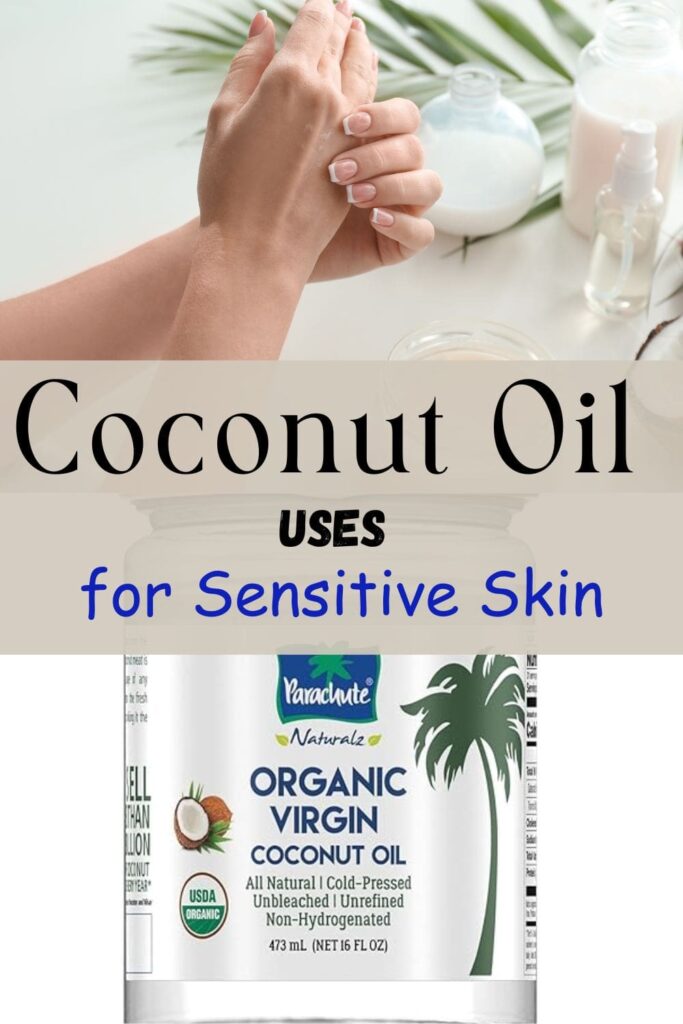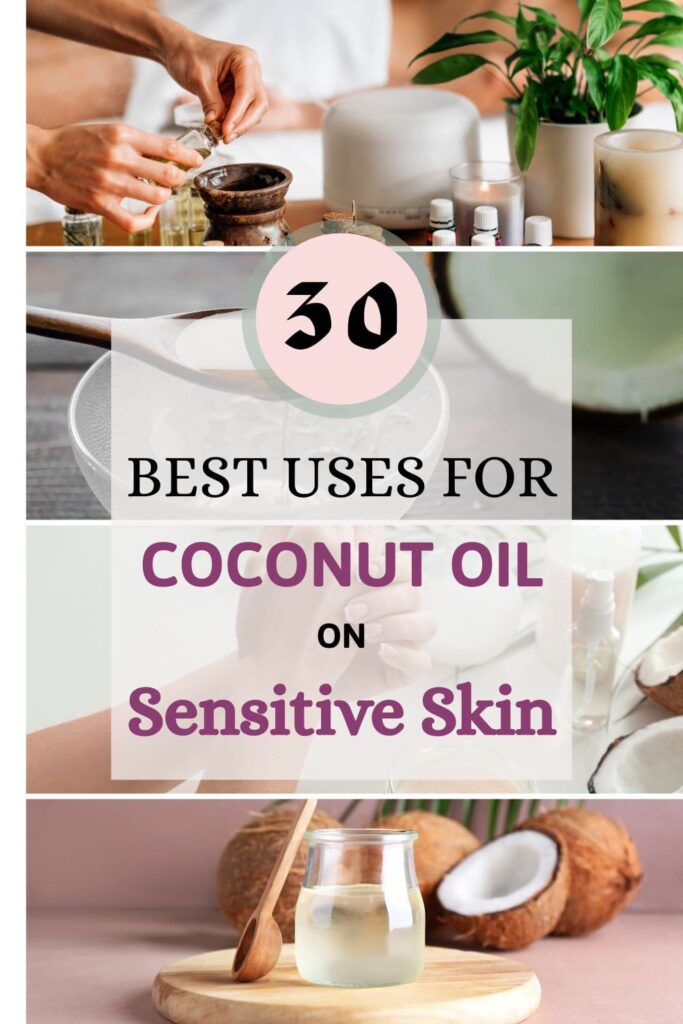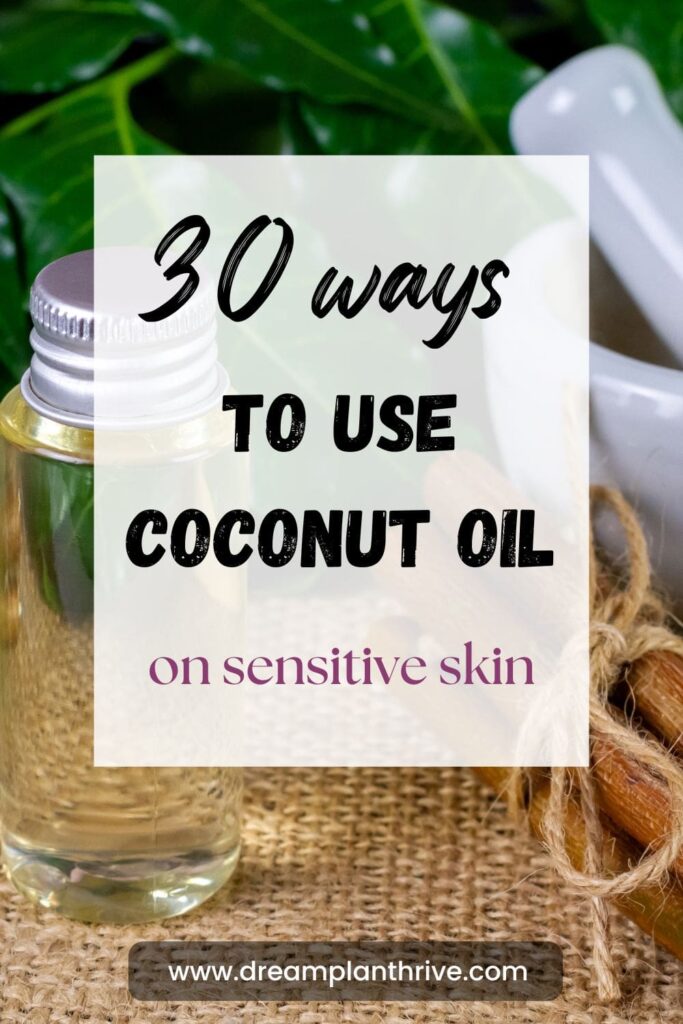
Coconut oil is the best food to introduce into your home. In addition to the benefits it has if you introduce it into your diet, it is also very useful for your skin, more specifically for sensitive skin.
In many cultures, coconut oil has a long history, used in diets, for skin and hair. And because it has great antibacterial and antimicrobial properties, it’s used extensively in some cultures to fight bacteria, fungi and some viruses by topical application of coconut oil.
It is very important to test a little coconut oil on a small patch of skin. Even though coconut allergies are rare, any new ingredient introduced into your life should be tested first.
Coconut oil is miraculous. I’ve been using it for many years in food, for hair masks, and for my skin, always with amazing results. In this article, I will talk a bit about how you can use coconut oil on sensitive skin. I always had problems with my sensitive skin, and I always searched for remedies to improve my skin’s appearance. Over the years, coconut have been a great addition to my skincare routine.
This post contains affiliate links, which means I may receive a small commission, at no cost to you, if you make a purchase through a link. Read the full disclosure here.
What type of coconut oil to use for sensitive skin
For sensitive skin, you need to be very careful about where the coconut oil comes from so that the oil does not contain chemical residues or irritants that can do worse to your skin.
Virgin or extra virgin coconut oil
- cold-pressed extraction—is a process in which the oil is extracted without high temperatures so that the nutrient is not lost.
- expeller-pressed extraction—uses a mechanical press at higher temperature to extract the oil, but may reduce some beneficial compounds compared to cold-pressed methods.
Refined (RBD) Processing
The oil undergoes refining steps to remove impurities, color, and odor, resulting in a neutral scent and taste. RBD stands for Refined, Bleached, and Deodorized.
Fractionated Coconut Oil (MCT Oil)
A secondary process that removes certain fatty acids (like lauric acid) to produce a liquid oil at room temperature. This process is used in cosmetics, aromatherapy and dietary supplements because is easily absorbed by our body.
If you don’t like the smell of coconut, fractionated coconut oil is a good choice. If you want to benefit from the full nutrient profile of coconut oil, then unrefined coconut oil (virgin or extra virgin) is the best choice.
How to incorporate coconut oil into your skincare routine
Here are 30 ways to incorporate coconut oil into your skincare routine, tailored for sensitive skin:
1. Gentle Facial Moisturizer
Warm a small amount between your palms and lightly pat onto clean skin to lock in moisture without harsh ingredients.
2. Makeup Remover
Massage a small dab onto your face to dissolve makeup, then wipe with a warm, damp cloth. This helps avoid the drying effects of typical cleansers.
3. Soothing Face Mask
Combine coconut oil with a little plain oatmeal or wheat bran. Apply for 10 minutes to calm redness and replenish moisture.
4. Nighttime Hydration
Use a thin layer as the final step in your nighttime routine to support overnight skin repair.
5. Eye Cream Substitute
Gently tap around the delicate eye area to soften fine lines. Use sparingly to avoid irritation.
6. Spot Treatment for Dry Patches
Apply a tiny amount to stubborn dry spots (like around the nose or between eyebrows) for quick relief.
7. Facial Massage Oil
Lightly massage your face to improve circulation. This technique can help reduce puffiness without overly stressing sensitive skin.
8. Neck and Neckline Care
Apply to neck and chest where skin can be thinner and prone to fine lines. Massage upward for a gentle lift.
9. Light Face Scrub Base
Mix with finely ground rice or wheat bran for a mild exfoliating scrub. Avoid applying excessive pressure when you have sensitive skin.
10. Hairline Moisture Shield
Dab a small bit along your hairline before using styling products to keep your scalp from drying out.
11. Lip Balm
Use as a nourishing solution for dry or chapped lips. Reapply as needed throughout the day.
12. Cuticle Softener
Massage into cuticles and nails to reduce dryness and keep hands looking well-groomed.
13. Hand Mask
Combine coconut oil with aloe vera gel and let it sit on your hands for several minutes under cotton gloves for ultra-hydration.
14. Cracked Heel Treatment
Before bed, rub on a small amount and slip on socks to help heal and soften sensitive or cracked heels.
15. Foot Massage
Warm coconut oil and massage gently into feet to soothe tired muscles and hydrate skin.
16. Gentle Body Moisturizer
Use after showering while skin is still damp for easier absorption.
17. Calming Bath Add-In
Stir a spoonful into a warm bath to lightly coat and soften your skin from head to toe. If you add a sachet with few spoons of wheat bran to the bath water, it will be a real treat for sensitive skin.
18. Body Scrub Blend
Mix with wheat barn for a gentle full-body exfoliation, focusing on rough areas but being mindful of sensitive patches.
19. Post-Shave Oil
Apply a thin layer to legs or underarms after shaving to soothe and protect skin from razor irritation.
20. Underarm Soother
Use after gentle exfoliation if underarms tend to get irritated from deodorants or shaving.
21. DIY Body Butter Base
Whip coconut oil with shea butter or cocoa butter for a thicker, more luxurious cream.
22. Sun-Damaged Skin Relief
Avoid applying coconut oil to skin that’s still hot and inflamed right away, as oil can potentially trap heat and worsen the symptoms. Instead, you can use other home remedies, such as cool baths and aloe vera. Apply coconut oil to heal and rehydrate after few days.
23. Mild Massage Oil
Ideal for overall body massages since it has fewer added chemicals compared to many commercial products.
24. In-Grown Hair Prevention
Apply a thin coat on areas prone to bumps to help soften hair follicles before hair removal.
25. Soothing Eczema Patches
Dab lightly on trouble spots to reduce dryness and itching.
26. Temples and Forehead Relaxation
Massage gently to help relax and possibly minimize stress-related tension in the face.
27. Calming Scalp Massage
If you have a sensitive scalp, lightly massage a bit of coconut oil in to reduce dryness and flaking.
28. Neck Mask
Combine coconut oil with a mashed banana to nourish the sensitive skin of your neck. Keep it on for 10 minutes and rinse with lukewarm water.
29. Stretch Mark Support
Gently massage onto areas prone to stretch marks (hips, thighs, abdomen) for extra nourishment.
30. Quick Dry Skin Fix
Keep a small container in your bag to dab onto any unexpectedly dry or irritated spots when you’re on the go.
Coconut oil offers numerous benefits to your body, but before introducing it into your life, whether for skin or for consumption, it is very important that it come from reliable sources and that the quality of the oil be guaranteed, without being contaminated with chemicals or other synthetic ingredients that can harm us.
Always test on small areas of skin to see if any negative reactions occur before using it on larger areas of skin. Coconut oil is comedogenic, and acne-prone skin may suffer. However, people with dry skin will be able to see significant improvements in the appearance of their skin.
Try one of these ideas for using coconut oil for sensitive skin and write a comment to share your experience with coconut oil.
Related Articles:








